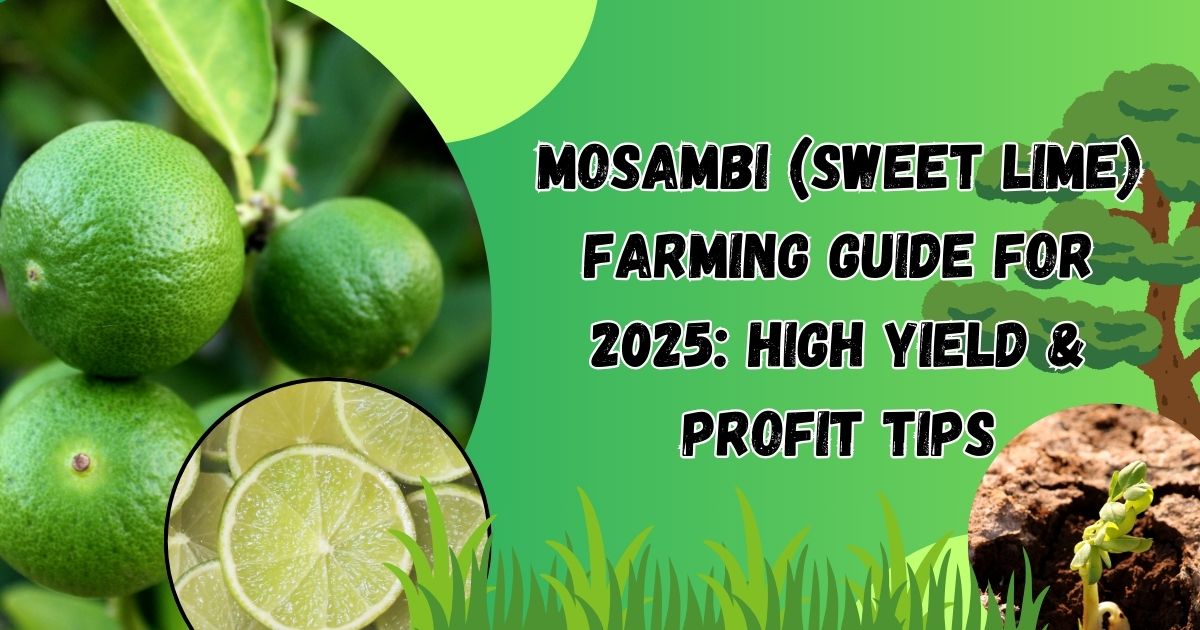Mosambi (Sweet Lime) Farming Guide for 2025: High Yield & Profit Tips
how to cultivate oranges Mosambi, also known as sweet lime or Citrus limetta, is one of India’s top citrus crops thanks to its sweet-flavored juice and health benefits. With modern agricultural practices, Mosambi farming can become a profitable venture for both new and experienced farmers. in this blog you will learn how to cultivate mosambi and what things to keep in mind while cultivating them

Table of Contents
Why Choose Mosambi Farming
High Market Demand: Sweet lime juice is in demand year-round in markets and juice bars.
Health Benefits: Rich in vitamin C and antioxidants.
Ease of Cultivation: Adapts well to tropical climates and yields multiple harvests annually.
Ideal Conditions for Mosambi Farming
Sunlight: Requires 6–8 hours of full sunlight daily for optimal growth and fruiting.
Soil: Well-drained sandy loam soil with pH 6–7; enriched with organic matter or compost.
Spacing: Plant trees 5–6 meters apart for proper air circulation and sunlight.
Planting Process
Select the Location: Choose an open space that receives sunlight most of the day.
Prepare the Pit: Dig a pit larger than the root ball and fill with a mix of soil and well-rotted manure.
Transplant the Sapling: Place the sapling so the top of the root ball is level with the soil surface, cover, and gently firm the soil.
Watering: Water deeply after planting; keep soil moist but not waterlogged. Increase irrigation during hot, dry spells.
Click on the button below for plants or seeds.
Care & Maintenance for Mosambi Farming
Fertilization: Feed with citrus-specific or balanced fertilizer every 6–8 weeks during the growing season. Organic manure boosts plant health.
Pruning: Light pruning after fruiting removes dead or weak branches and enhances air circulation.
Weeding: Perform manual weeding at the base of the plant every 3–4 months.
Common Varieties
Mosambi
Mousambi
Sweet Lemon
Sweet Limetta
- Malta
High Quality Drumstick Seeds Available 🎋
— Annadata Trading Company (@ATCSEEDS) September 9, 2025
✅ High Germination Rate.
✅ Best for Farming.
✅ Fast Growth & Strong Plants.
✅ Suitable for All Soil Type
🧑💻Order Now: 👇
🏢 Annadata Trading Company
☎️ 092844 02685 #drumstickseed #moringaseed #deumstickfarming #seeds pic.twitter.com/xXE5kfJ2f4
Disease & Pest Control
Mulching: Use organic mulch to conserve moisture and suppress weeds.
Pest Management: Monitor regularly and use natural remedies or recommended pesticides as needed.
Yield & Harvest
Mosambi trees begin bearing fruit in 3–4 years after planting.
Best harvests are from December to February, March to May, and June to September in suitable climates.
With proper care, you can expect high yields and strong market profits.
Conclusion
Mosambi farming is a lucrative and sustainable agricultural option in 2025. By following proper planting, care, and harvest techniques, you can achieve healthy growth and high yields.
FAQs
1. What is the best season to plant Mosambi trees?
Mosambi trees are best planted between October and January in most parts of India. This period supports good root establishment before the hotter months.
2. What type of soil and spacing is ideal for Mosambi cultivation?
Mosambi thrives in well-drained loamy or red soils with a pH range of 6.5 to 7.5. Spacing should be around 20 to 22 feet (6 to 7 meters) between plants to accommodate their growth and allow air circulation.
3. How much water do Mosambi trees require?
Regular watering is essential, especially during dry spells. Avoid waterlogging as it can cause root rot. Drip irrigation is recommended for efficient water use.
4. When do Mosambi trees start bearing fruit?
Mosambi trees typically begin flowering within 3 years of planting, with harvestable fruit from the 4th year onwards. Peak yield often occurs at 8–10 years of age.
5. What fertilizers and nutrients are recommended for Mosambi?
Organic manure (farmyard manure) is applied annually, starting at 10 kg/plant and increasing with tree age.
Nitrogen, phosphorus, and potassium are applied in specific doses according to tree age.
Micronutrients like zinc, iron, and manganese may also be sprayed periodically.
6. How to manage pests and diseases in Mosambi farming?
Common pests include leaf miner, citrus psylla, scale insects, and aphids. Diseases like citrus canker, gummosis, and powdery mildew may also affect crops. Use integrated pest management (IPM) techniques including biological controls, neem oil sprays, and proper orchard sanitation.
7. Can intercrops be grown with Mosambi?
Yes, in the initial 3 years, short-duration legumes (e.g., green gram, black gram) can be grown between Mosambi rows to utilize space and improve soil fertility.
8. How many harvests can be expected annually?
Mosambi can yield two harvests per year: one around April–May and another from August–September, depending on the region and orchard management.
9. What is the expected yield and profitability of Mosambi farming?
Initial yields can be about 60 kg per plant or 5 tonnes per acre after 4 years.
Mature orchards can produce around 100 kg per plant or 9 tonnes per acre.
Market prices and demand directly influence profitability, but well-managed orchards can be quite lucrative.
10. What are common challenges in Mosambi cultivation?
- Water management to avoid stress or root diseases.
- Pest and disease outbreaks.
- Maintaining soil fertility over time.
- Proper pruning and harvesting techniques to maximize fruit quality.
